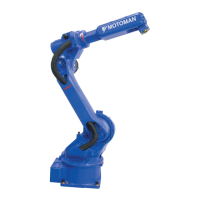3 Developing with MLX200
3.3 Programming Introduction
3-17
168542-1CD
168542-1CD
MLX200 Software and
Operations
3.3.7 Error Messages
In the case of an error, the system will abort and then report an error code
to the MLx[].SystemErrorCode variable. This error code will map to the
errors listed in Appendix C. If using the MLX-HMI, there should also be a
detailed error message displayed on the {HMI} screen. If not, the
MLxGetErrorDetail instruction can be used to populate a variable of type
MLxErrorDetail. This object will contain detailed error messages as well as
information on how to recover from and avoid the error. An example for a
position limit error is shown in Fig. 3-17
Fig. 3-17: Example Detailed Error Message
Table 3-4: MLxErrorDetail Parameters
3.3.8 Stopping and Recovering Robot Motion
There are multiple ways to stop a robot's motion either from the MLX-HMI,
the application logic using the MLX state commands (e.g. MLxAbort) or
the MLX200 Drive Panel. The motion can be “aborted” by pressing the
[ABORT] button the HMI, calling MLxAbort, by pressing in the
[EMERGENCY STOP] button on the control panel, or by opening the
Guard Circuit on the control panel. The robot motion can be “held” by
pressing the [HOLD] button on the HMI or calling the MLxHold instruction.
Finally, the robot motion can be “stopped” by pressing the [STOP] button
on the HMI or using the MLxStop instruction. The following sections
describe the behavior of each of these and the different recovery methods
for each.
errorNumber The MLX error number
OEMerrorNumber OEM Error number if error code comes
from 3rd party device (Servo Drive, I/O
Module, etc)
Origin 0 = MLX200 Control Module,
1 = Servo Drive
Type 0 = Alarm/Fault, 1 = Warning
Recovery 0 = No Action Required, 1 = Software
Reset Required, 2 = Hardware Reset
(System Restart) Required
Message Basic Error Message
ExtendedDescription1 Extended error description
ExtendedDescription2 Extended error description (continued)
Remedy Description of how to troubleshoot and
prevent error.

